Apps
Auto Added by WPeMatico
Auto Added by WPeMatico
Facebook wants to make YouTube-style monologue videos the new way for politicians to talk straight with their constituency. Today, Facebook launches Candidate Info, featuring thousands of direct-to-camera vertical videos where federal, state and local candidates introduce themselves and explain their top policy priority, qualifications and biggest goal if they win office. Elizabeth Warren (D – MA Senate), Scott Walker (R – WI Governor) and Beto O’Rourke (D – TX Senate) have already posted, and Facebook expects more candidates to jump in shortly.
These videos will soon be available as part of an Election 2018 bookmark in the Facebook mobile app’s navigation drawer. And starting next week, the clips will begin appearing to potential constituents in the News Feed.

Facebook tells me these videos will make it easier for people to learn about and compare different candidates. The effort extends the Town Hall feature Facebook launched in 2017 that offers a personalized directory of candidates they could vote for. Candidate Info will similarly only show videos from politicians running in elections relevant to a given user, so if you’re in California you won’t see videos from the Texas senate race between O’Rourke and Ted Cruz. But you can still find their videos on their Facebook Pages.
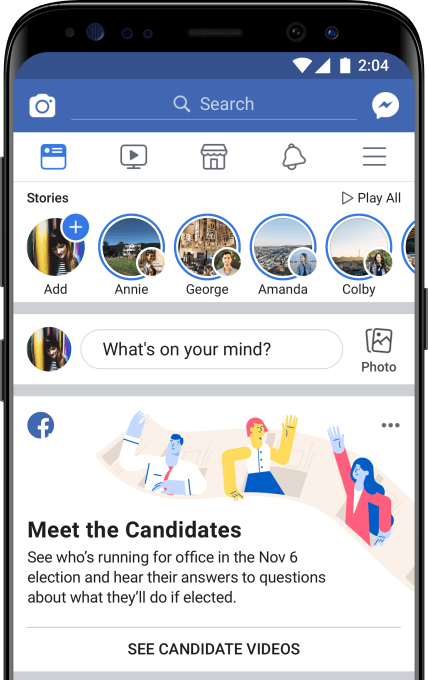
With the mid-terms fast approaching, Facebook is trying to do everything it can to protect against election interference by foreign and domestic attackers, offer transparency about who bought campaign ads, connect users to candidates and encourage people to register and vote. With fake news that spread through the social network thought to have influenced the 2016 election, and ill-gotten Facebook user data from Cambridge Analytica applied to Donald Trump’s campaign ad targeting, Facebook is hoping to avoid similar problematic narratives this time around.
You can see some examples of Candidate Info videos below from O’Rourke and Wisconsin Governor Scott Walker.
Powered by WPeMatico
If Facebook Messenger’s redesign succeeds, you won’t really notice it even happened. I hardly did over the past week of testing. There’s just a subtle sense that the claustrophobia has lifted. Perhaps that’s why Facebook decided to throw a big breakfast press event with 30 reporters today at its new downtown San Francisco office, complete with an Instagram-worthy donut wall. Even though the changes are minimal — fewer tabs, color-gradient thread background and a rounder logo — Facebook was eager to trigger an unequivocally positive news cycle.
In the seven years since Facebook acquired group chat app Beluga and turned it into Messenger, it’s done nothing but cram in more features. With five navigation bar options, nine total tabs, Stories, games and businesses, Messenger’s real purpose — chatting with your friends — started to feel buried. “You build a feature, and then you build another feature, and they are piling up,” says Facebook’s head of Messenger Stan Chudnovsky. “We either continue to pile on, or we build a foundation that will allow us to build simplicity and powerful features on top of something new that goes back to its roots.”
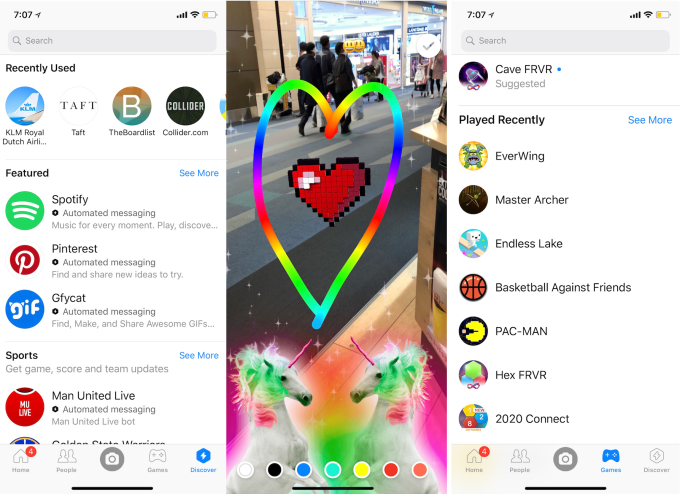
The old, overloaded Messenger
But suddenly uprooting the old design with a massive overhaul wasn’t an option. “It’s impossible to launch something for 1.3 billion people that will not piss people off,” Chudnovsky told me. “It takes so much time to test things out and make sure you’re not doing something that will prevent people from doing things that are really, really important to them. At the end of the day, no one really likes change. People generally want things the way they are.”
So starting today, Messenger is globally rolling out an understated redesign globally over the next few weeks. It’s got a simpler interface with a lot more white space, a little less redundancy and a casual vibe. Here’s a comparison of the app before and after.
Old Messenger:
Previously, there were five main navigation buttons along the bottom of the app. Between the actually useful Chats section that’d been invaded by Stories and the chaotic People section, there were tabs for calls, group chats and active friends. Between them was a camera button that aggressively beckoned you to post Stories, a dedicated Games tab and a Discover tab for finding businesses and utility app.
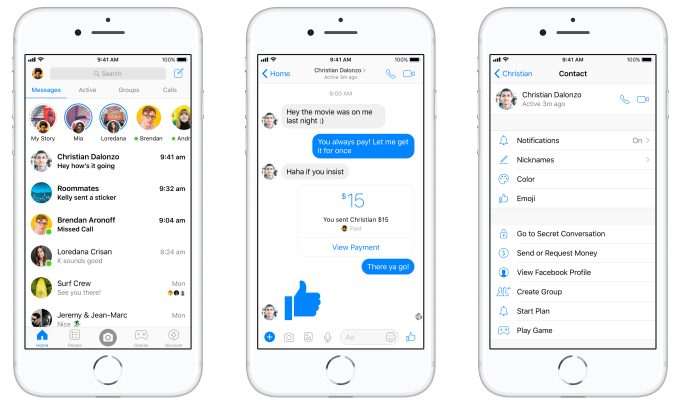
New Messenger:
In Messenger v4, now there are just three navigation buttons. The camera button has been moved up next to the chat composer inside the Chat section above Stories, People now contains the Active list as well as all Stories by friends, and Discover combines games and businesses. The fact that Stories is in both the Chats and People section make it seem that the company wants a lot more than the existing 300 million users across Facebook and Messenger opening its Snapchat copycat.
While 10 billion conversations with businesses and 1.7 billion games sessions happen on Messenger each month, and both hold opportunities for monetization, they’re not the app’s purpose, so they got merged. And though 400 million people — nearly a third of all Messenger users — make a video or audio call each month, those typically start from a button inside chat threads, so Facebook nixed the Calls tab entirely.
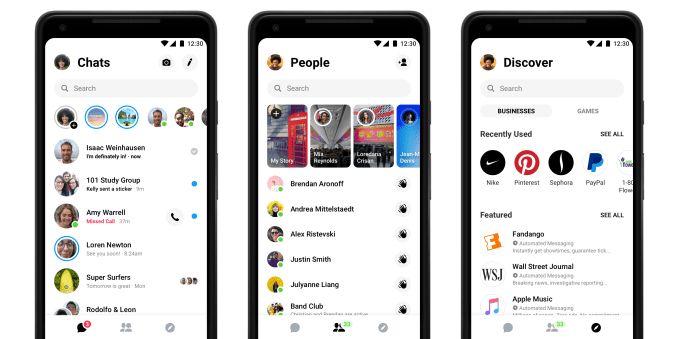
All the old features are still available, just not quite as prominent as before. The one new feature is several color gradients you can use to customize specific chat threads. If you rapidly scroll through the messages, you’ll see the bubble background colors fade through the gradient. And one much-requested feature still on the way is Dark Mode, which Facebook says will launch in the next several weeks to reduce glare and make night-time usage easier on the eyes.
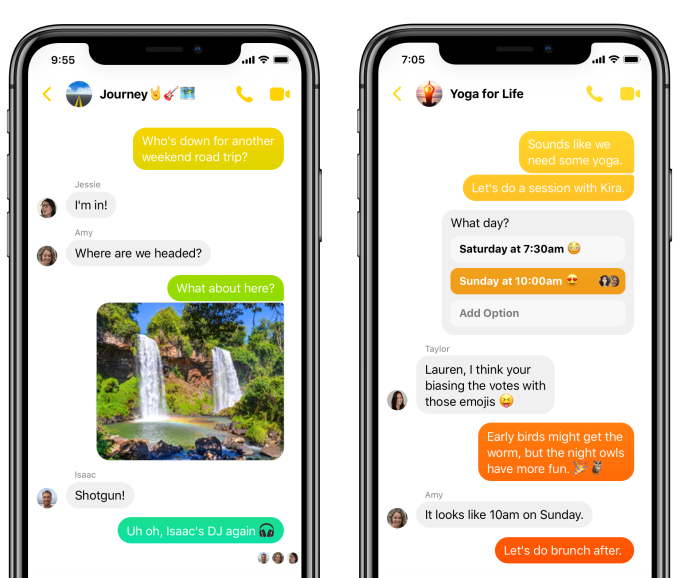
Finally, Messenger has a softer new logo. The sharp edges have been rounded off the quote bubble and lightning insignia. It seems designed to better compete with Snapchat and remind users that Messenger is fun and friendly, as well as fast.
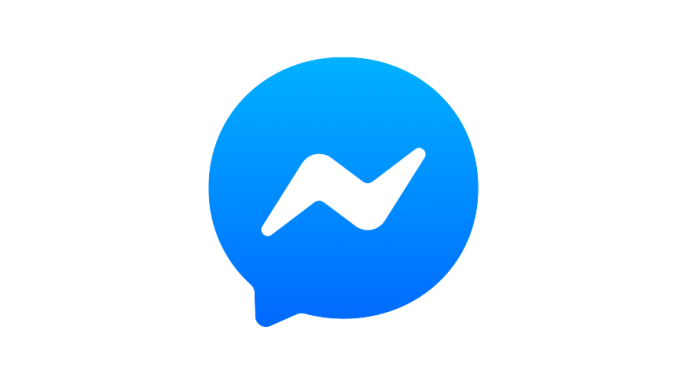
With the company’s downward scandal spiral of breaches, election interference and fake news-inspired violence, it’s not just Messenger that’s a mess. It’s all of Facebook, both literally and metaphorically. Cleaning up, fighting back — those are the messages the company wants to drive home.
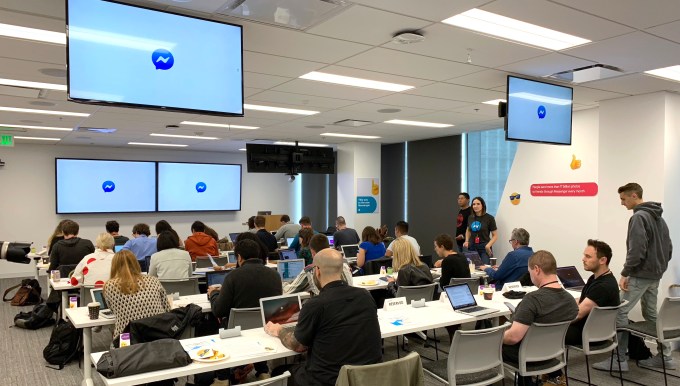
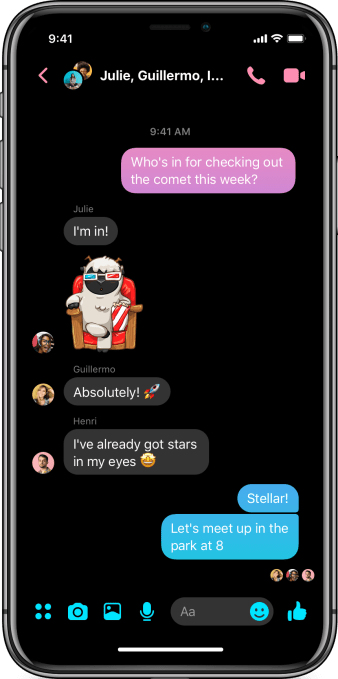 Facebook scored a win on this front last week by getting dozens of journalists (myself included) to breathlessly cover its election “war room,” until everyone realized they’d played themselves for page views. Today’s Messenger event felt a little like déjà vu as Facebook drilled the word “simple” into our heads. Chudnovsky even acknowledged that Facebook had already milked the redesign for a press hit back in May. “We previewed this at F8 but that was when the work was just beginning.”
Facebook scored a win on this front last week by getting dozens of journalists (myself included) to breathlessly cover its election “war room,” until everyone realized they’d played themselves for page views. Today’s Messenger event felt a little like déjà vu as Facebook drilled the word “simple” into our heads. Chudnovsky even acknowledged that Facebook had already milked the redesign for a press hit back in May. “We previewed this at F8 but that was when the work was just beginning.”
Hopefully, this will be the start of a company-wide interface cleanup. Facebook’s main app is full of cruft, especially with products like Facebook Watch stuffed in the nav bar despite lukewarm user interest. Messenger did a good job of ceasing to shoehorn the camera and games into our chat behavior, though Stories still appear twice in the app even if some wish they disappeared permanently. The world would benefit from a Facebook more concerned with what users want than what it wants to show them.
With the news going live just an hour after the event ended, many reporters stayed, writing their posts about Facebook while still inside Facebook. Chudnovsky admitted that beyond educating users via the press, the event was designed to celebrate the team that had labored over each pixel. “You can imagine at a company like ours, how many conversations you have to have about changing the logo.”
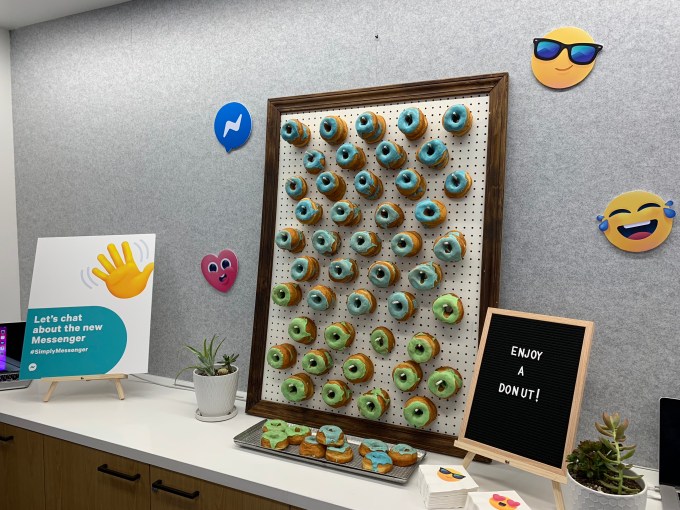
Powered by WPeMatico
There’s a war brewing to become the cloud pharmacy for men’s health. Roman, which launched last year offering erectile dysfunctional medication and recently added a ‘quit smoking’ kit, is taking on $97 million-funded Hims for the hair loss market. Today, Roman launched four new products it hopes to cross-sell to users through a unified telemedicine subscription and pill delivery app. It now sells meds for premature ejaculation, oral herpes, genital herpes, and hair loss at what’s often a deep discount versus your local drug store. And for those who are too far gone, it’s launching a “Bald Is Beautiful, Too” microsite for finding the best razors, lotions, and head shaving tips.

Roman CEO Zachariah Reitano
“It’s unlikely that you’ll buy razors from Bonobos or pants from Dollar Shave Club. But with a doctor, it’s actually the exact opposite” Roman CEO Zachariah Reitano tells me. “As a customer you’re frustrated if they send you somewhere else.” And so what started as a single product startup is blossoming into a powerful product mix that can keep users loyal.
Roman starts with a telemedicine doctor’s visit where patients can talk about their health troubles without the embarrassment of going to their general practitioner. When appropriate, the doc can then prescribe medications customers can then instantly buy through Roman.
“If you have something that’s truly consuming your day-to-day, it makes it really hard or nearly impossible to think about the long-term. If you’re 30 pounds overweight and experiencing erectile dysfunction, [it’s the latter symptom] that’s dominating your head space” Reitano explains. The doctor might focus on the underlying health issue, but most humans aren’t so logical, and want the urgent issue fixed first. Reitano’s theory is that if it can treat someone’s erectile dysfunction or hair loss first, they’ll have the resolve to tackle bigger lifelong health challenges. “We’re hoping to work on this so you can take a deep breath and get the monkey off your back” the CEO tells me.
But one thing Roman won’t do is prescribe homeopathic remedies or spurious remedies. “We will only ever offer products that are backed by science and proven to work” Reitano declares. Taking a shot at Roman’s competitor, he says “Hims sells gummies. Roman does not. No doctor would say Biotin would help you regrow hair”, plus the vitamin can distort blood pressure readings that make it tough to tell if someone is having a heart attack.
“Roman will never slap sugar on vitamins, sell them on Snapchat, and say they’ll regrow your hair” Reitano jabs. Roman also benefits from the fact that Reitano’s father and one of the company’s advisors Dr. Michael Reitano was a lead author on a groundbreaking study about how Valacyclovir could be used to suppress transmission of genital herpes.
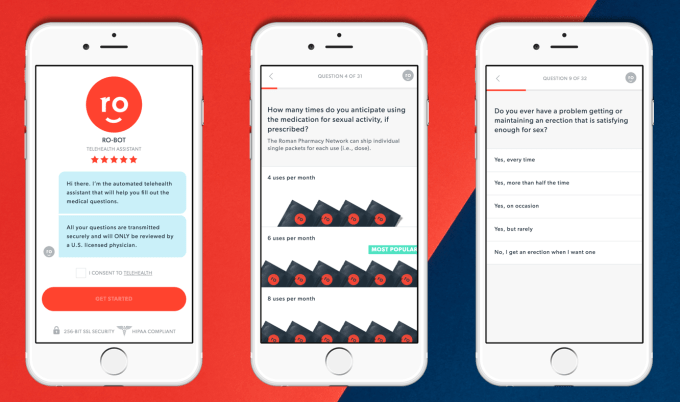
So what is Roman selling?
With Roman, Hims, Amazon acquisition PillPack, and more, there’s a powerful trend in direct-to-consumer medication emerging. Reitano sees it as the outcome of five intersecting facts.

Roman’s $88 million Series A it announced last month is proof of this growing trend. Investors see the traditional pharmacy structure as highly vulnerable to disruption.
Roman will have to defeat not just security threats and competitors, but also the status quo of keeping a stiff upper lip. A lot of men silently suffer these conditions rather than speak up. By speaking candidly about his own erectile dysfunction as a side-effect of heart medication, Reitano is trying to break the stigma and get more patients seeking help wherever feels right to them.
Powered by WPeMatico
Google Play has generated more than twice the downloads of the iOS App Store, reaching a 70 percent share of worldwide downloads in 2017, according to a new report from App Annie, released in conjunction with the 10th anniversary of the Android Market, now called Google Play. The report also examined the state of Google Play’s marketplace and the habits of Android users.
It found that, despite the large share of downloads, Google Play only accounted for 34 percent of worldwide consumer spend on apps, compared with 66 percent on the iOS App Store in 2017 — a figure that’s stayed relatively consistent for years.
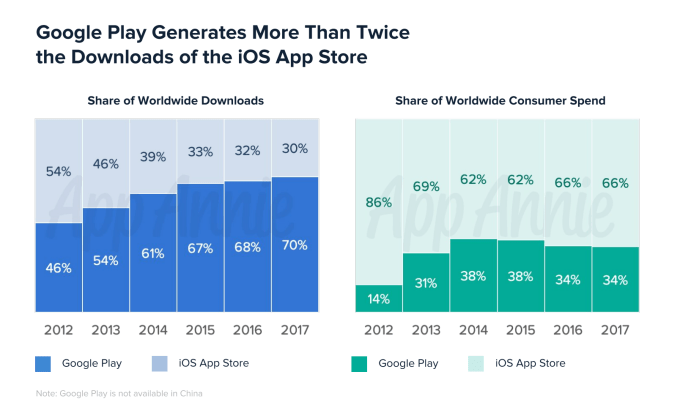
Those numbers are consistent with the narrative that’s been told about the two app marketplaces for some time, as well. That is, Google has the sheer download numbers, thanks to the wide distribution of its devices — including its reach into emerging markets, thanks to low-cost smartphones. But Apple’s ecosystem is the one making more money from apps.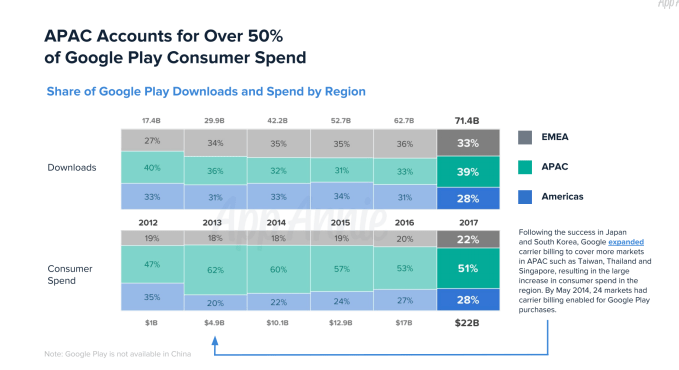
App Annie also found that the APAC (Asia-Pacific) region accounts for more than half of Google Play consumer spending. Japan was the largest market of all-time on this front, topping the charts with $25.1 billion dollars spent on apps and in-app purchases. It was followed by the U.S. ($19.3 billion) and South Korea ($11.2 billion).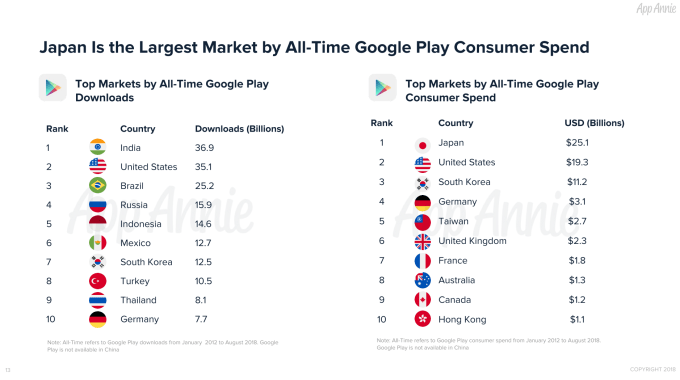
The firm attributed some of Google Play’s success in Japan to carrier billing. This has allowed consumer spending to increase in markets like South Korea, Taiwan, Thailand and Singapore, as well, it said.
As to what consumers are spending their money on? Games, of course.
The report found that games accounted for 41 percent of downloads, but 88 percent of spend.
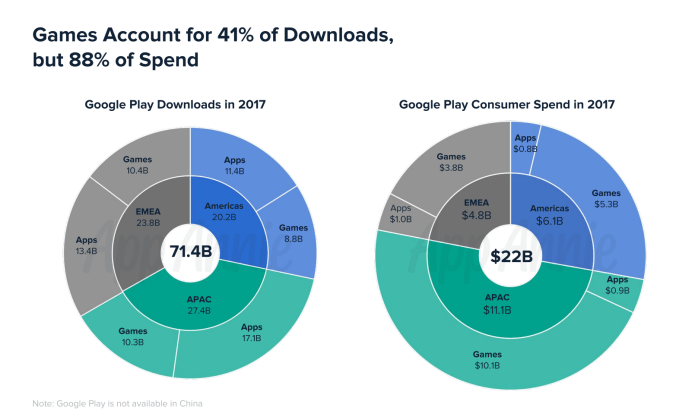
Outside of games, in-app subscriptions have contributed to revenue growth.
Non-game apps reached $2.7 billion in consumer spend last year, with 4 out of the top 5 apps offering a subscription model. The No. 1 app, LINE, was the exception. It was followed by subscription apps Tinder, Pandora, Netflix and HBO NOW.
In addition, App Annie examined the app usage patterns of Android users, and found they tend to have a lot of apps installed. In several markets, including the U.S. and Japan, Android users had more than 60 apps installed on their phones, and they used more than 30 apps every month.
Australia, the U.S. and South Korea led the way here, with users’ phones holding 100 or more apps.

The report also looked at the most popular games and apps of all time by both downloads and consumer spend. There weren’t many surprises on these lists, with apps like those made by Facebook dominating the top apps by downloads list, and subscription services dominating top apps by spend.
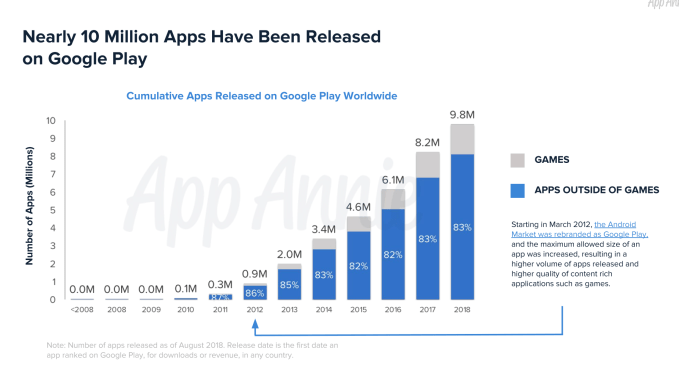
App Annie also noted Google Play has seen the release of nearly 10 million apps since its launch in 2008. Not all these remain, of course — by today’s count, there are just over 2.8 million apps live on Google Play.
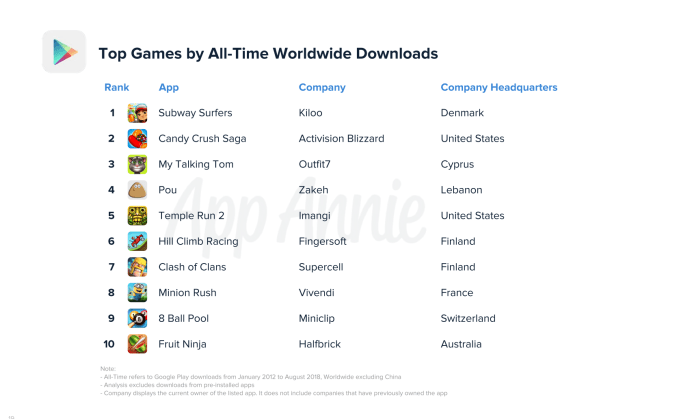
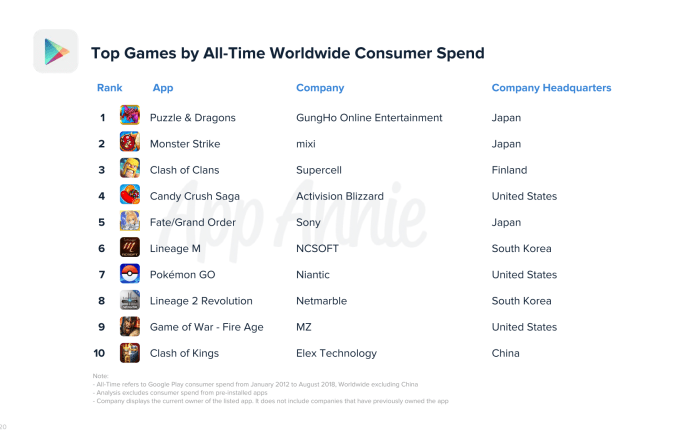

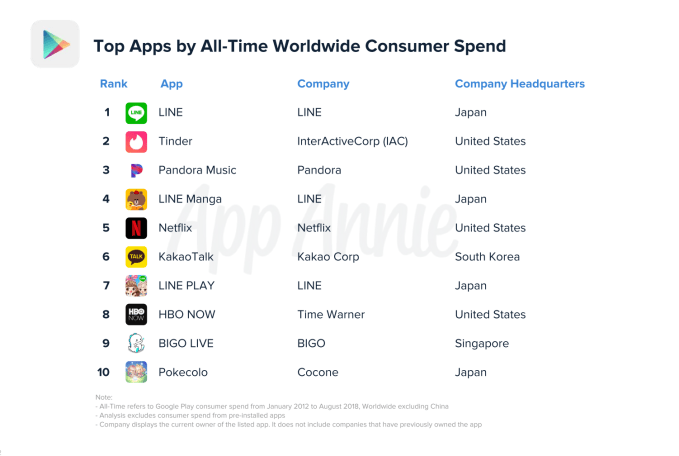
The full report is available here.
Powered by WPeMatico
How can Lime differentiate its scooters and bikes from the piles of Birds and Spins filling Los Angeles sidewalks? Apparently with a physical storefront where it can convince customers of the wonders of on-demand mobility. According to a job listing from Lime seeking a “Retail Store Manager,” the startup plans to open a “lifestyle brand store in Santa Monica”.
[Update: Following the publication of this article, Lime responded to our inquiry, telling TechCrunch “In the coming year, Lime will be opening brick & mortar storefronts in major US and international markets, starting with Santa Monica, California. Locations will place heavy importance on community engagement, rider education, and brand experience.”]
Lime will rent vehicles directly from the store as well as charge them, with the full-time manager’s role including “monitoring inventory levels” as well as daily operations, and employee recruiting. They’ll also be throwing live events to build Lime’s hype. Given the company is calling this a lifestyle store, the focus will likely be on showing how Lime’s scooters and bikes can become part of people’s lives and enhance their happiness, rather than on maximizing rental volume.
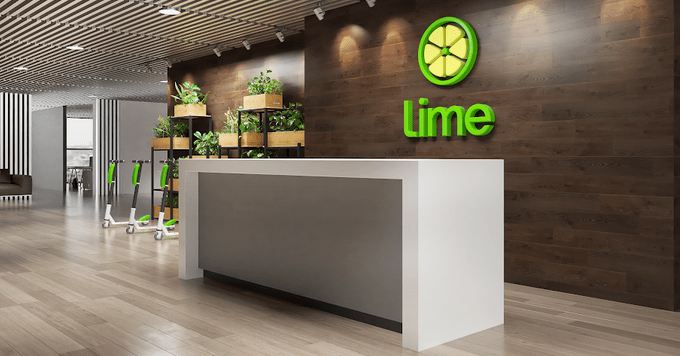
A rendering of Lime’s new office it’s building in San Francisco. The design could hint at what Lime wants to do with its retail store branding.
TechCrunch has confirmed Lime’s plans for the store, and that the deal to build it came through Lime’s investor Fifth Wall Ventures that arranges partnerships between tech companies and real estate developers. As for what will happen at the store, Fifth Wall’s Adam Demuyakor tells me “There will be deployment of scooters, charging of scooters, and some sales of apparel and accessories that are related. There will be demos, tutorials, and presentations on how to be safe.” Growing Lime’s traction is critical to Fifth Wall, which led the startup’s $70 million Series B extension in February, and joined its $335 million Series C in July.
The big motive here is for Lime to repair relationships with the local community. Demuyakor tells me “when e-mobility companies appeared, some people really loved it, but some people said ‘you dropped a bunch of scooters on my sidewalk’” in what he called a “really irresponsible manner”. But with a physical store front, Lime will have human faces to push its side of the story. “Lime would have an opportunity to control the narrative, engage with the local community, and invest in Santa Monica. They can make it clear that they care about the constituency there . . . Educate them on the benefits, educate them on safety, and provide helmets.” That could counter the idea that scooters just get in the way and are an urban eye sore. “The narrative took on legs of its own” Demuyakor explains.
Fifth Wall worked on the Lime retail store deal with one of its core LPs, Macerich, the third-largest owner of shopping malls in the US. Lime will become the exclusive distributor of scooters at the Macerich-owned open-air mall Santa Monica place. The idea is that by linking up with Macerich, Lime will be able to deploy and charge scooters “where people are coming and going from the mall” Fifth Wall co-founder and managing partner Brendan Wallace tells TechCrunch. He explains that scooter companies have thought about expansion too purely from the standpoint of acheiving market saturation. “You have to partner with local organizations both public and private, and real estate organizations because real estate developers are typically the most politically influential.”]
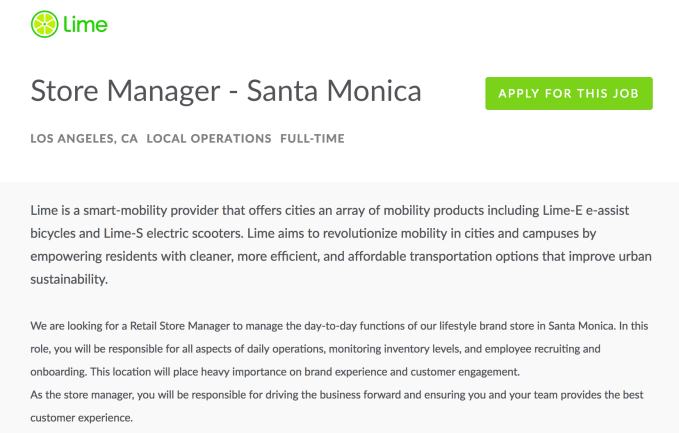
The listing was first spotted by Nathan Pope, a transportation researcher for consultancy Steer, and later by Cheddar’s Alex Heath. We’ve reached out to Lime and will update if we hear back from the company. Glassdoor shows that the store manager job was posted more than 30 days ago, and the site estimates the potential salary at $41,000 to $74,000.
 The sheer number of Lime scooters in Santa Monica where the store will arise is already staggering. Supply doesn’t seem to be bottlenecking as it is in some other cities. Instead, it’s the fierce competition from hometown startups like local favorite Bird that Lime wants to overcome through brick-and-mortar marketing. Often you’ll see scooters from Lime and Bird lined up right next to each other. And with similarly cheap pricing, the decision of which to use comes down to brand affinity. According to Apptopia, Bird’s monthly U.S. downloads surpassed Lime’s in July for the first time ever, despite Lime offering bikes as well as scooters.
The sheer number of Lime scooters in Santa Monica where the store will arise is already staggering. Supply doesn’t seem to be bottlenecking as it is in some other cities. Instead, it’s the fierce competition from hometown startups like local favorite Bird that Lime wants to overcome through brick-and-mortar marketing. Often you’ll see scooters from Lime and Bird lined up right next to each other. And with similarly cheap pricing, the decision of which to use comes down to brand affinity. According to Apptopia, Bird’s monthly U.S. downloads surpassed Lime’s in July for the first time ever, despite Lime offering bikes as well as scooters.
There are plenty of people who still have never tried an on-demand electric scooter, and going through the process of renting, unlocking and riding them might be daunting to some. If employees at a physical store can teach people that it’s not too difficult to jump aboard, Lime could become their default scooter. This, of course, comes with risks too, as electric scooters can be dangerous to the novice or uncoordinated. More aggressive in-person marketing might pull in users who were apprehensive about scooting for the right reason — concerns about safety. And there’s also the issue of overhead costs. Beyond charging and repair facilities near its major markets, brick-and-mortar stores could crank up the burn rate on Lime’s $467 million in funding.
As cities figure out how to best regulate scooters, I hope we see a focus on uptime, aka how often the scooters actually function properly. It’s common in LA to rent a scooter, then discover the handlebar is loose or the acceleration is sluggish, end the ride and rent another scooter from the same brand or a competitor in hopes of getting one that works right. I ditched several Lime scooters like this while in LA last week.
Regulators should inquire about what percentage of scooter company fleets are broken and what percentage of rides end within 90 seconds of starting, which is typically due to a malfunctioning vehicle. Cities could then award permits to companies that keep their fleets running, rather than that litter the streets with massive paper weights, or worse, vehicles that could crash and hurt people. Scooters are fun, cheap and therefore accessible to more people than Ubers, and reduce traffic. But unless startups like Lime put a bigger focus on helmets and cautious riding behavior, we could trade congestion on the roads for congestion in the emergency room. Hopefully the retail store will drive closer ties between Lime and city governments to prioritize safety.
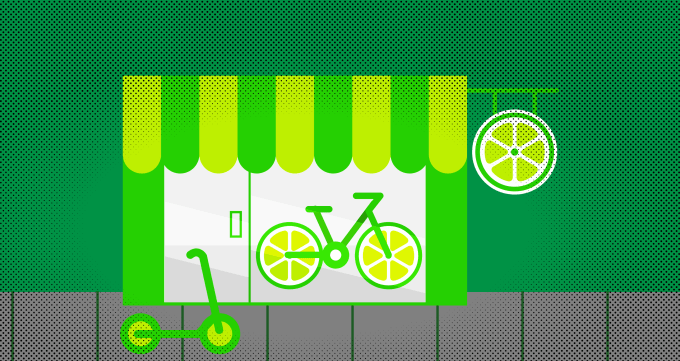
This article has been updated to include Lime’s statement as well as comments from Fifth Wall Ventures.
Powered by WPeMatico
The team behind mileage-tracking app MileIQ, a company Microsoft acquired a few years ago, is out with a new application. This time, the focus isn’t on tracking miles, but rather expenses. The new app, simply called “Spend,” arrived on the App Store on Thursday, offering automatic expense tracking for work reimbursement purposes or for taxes.
Spend doesn’t appear to be a part of some grand Microsoft plan to take on expense tracking industry giants, like Expensify or SAP-owned Concur, for example. At least, not at this time.
Instead, the app is a Microsoft Garage project, the App Store clarifies.
Microsoft Garage is the company’s internal incubator when employees can test out new ideas to see if they resonate with consumers and business users.
Through the program, a number of interesting projects have gotten their start over the years, like the Cortana-based dictation tool, Dictate; mobile design creation app Sprightly; short-form email app Send; the Word Flow keyboard for smartphones; a Bing-backed alternative to Google News; and dozens more.
The new Spend app, at first glance, looks well-designed and easy to use.
Like most expense trackers, it offers features like the ability to take photos of receipts, expense categorization features, and reporting.
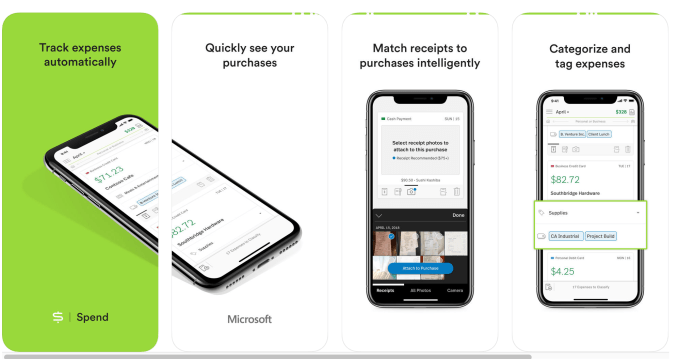
However, what makes Spend interesting is the app’s automated tracking and matching, and its user interface for working with your receipts.
The app begins by automatically tracking all your expenses from a linked credit card or bank account. You can then swipe on the expenses to mark them as personal or business. These expenses are automatically categorized, and you can add extra tags for added organization.
You can also add notes to purchases, split expenses, and customize expense categories, in addition to tags.

And the app can generate expense reports on a weekly, monthly or custom bases, which can be exported at spreadsheets or PDFs. There’s a web dashboard for when you’re using the app at your computer, but Spend doesn’t appear on the MileIQ main website at this time. It does, however, have a support site.
How well this all works, in practice, requires further testing.
MileIQ had been the top-grossing finance app in Apple’s App Store for the last 20 months at the time of its acquisition back in 2015. Microsoft had said then the team would work on other mobile productivity solutions going forward.
Since joining Microsoft, the team that created MileIQ has added capabilities to MileIQ, such as MileIQ for Teams, new intelligence features and a partnership with Xero. MileIQ is also now included with Microsoft 365 Business and Office 365 Business Premium plans
However, Spend is the first standalone app built by the team in that time.
The company says the new Spend app is an early version, and they plan to revise it going forward as they make improvements.
Microsoft responded to a request for comment, but didn’t provide any details about its eventual plans for Spend, like whether it will have business model or be included with Office subscriptions.
10/19/18: Updated after publication with information about Microsoft’s comments.
Powered by WPeMatico
In another example of VR bleeding into real life, Cornell University food scientists found that cheese eaten in pleasant VR surroundings tasted better than the same cheese eaten in a drab sensory booth.
About 50 panelists who used virtual reality headsets as they ate were given three identical samples of blue cheese. The study participants were virtually placed in a standard sensory booth, a pleasant park bench and the Cornell cow barn to see custom-recorded 360-degree videos.
The panelists were unaware that the cheese samples were identical, and rated the pungency of the blue cheese significantly higher in the cow barn setting than in the sensory booth or the virtual park bench.
That’s right: cheese tastes better on a virtual farm versus inside a blank, empty cyberia.
“When we eat, we perceive not only just the taste and aroma of foods, we get sensory input from our surroundings – our eyes, ears, even our memories about surroundings,” said researcher Robin Dando.
To be clear, this research wasn’t designed to confirm whether VR could make food taste better but whether or not VR could be used as a sort of taste testbed, allowing manufacturers to let people try foods in different places without, say, putting them on an airplane or inside a real cow barn. Because food tastes differently in different surroundings, the ability to simulate those surroundings in VR is very useful.
“This research validates that virtual reality can be used, as it provides an immersive environment for testing,” said Dando. “Visually, virtual reality imparts qualities of the environment itself to the food being consumed – making this kind of testing cost-efficient.”
Powered by WPeMatico
For the first time, Uber will make contextual, personalized suggestions about the best way to get from point A to point B. The startup offers more than just cars now, and it’s starting to understand the trade-offs between price, speed, convenience and comfort amidst its multi-modal fleet. Most noticeably, you’ll soon see JUMP bikes get premier billing right alongside Uber’s other vehicles. Going a short distance and there’s a charged up bike nearby? Uber will suggest you pedal. Might need extra room for luggage on your way to the airport? UberXL and SUV will appear. Always take cheap Pools? It won’t show you a pricier Black car.
Uber is finally getting smart. It has to if it’s going to make sense of its growing patchwork of ride types without overwhelming passengers with too many options. Uber’s algorithm can help them choose. “We think there’s a lot to be gained by being a one-stop shop to get somewhere,” says Uber director of product Nundu Janakiram.
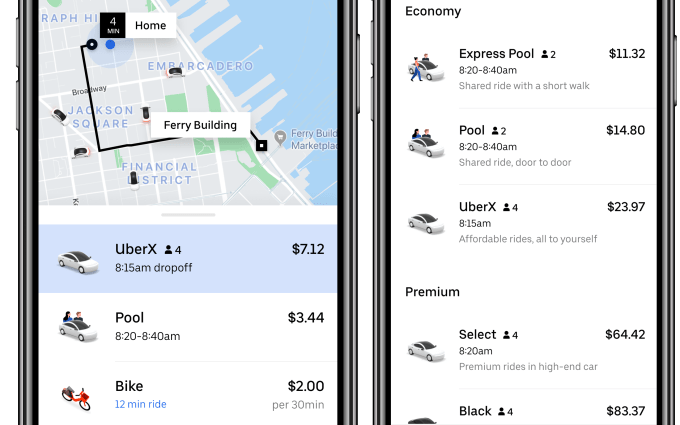
Uber now dynamically recommends different ride types
In particular, Uber could block disruption by scooter-specific startups like Spin, Bird or Skip. If those apps have no vehicles nearby or you’re going too far, they’ve got nothing to offer. But Uber can provide a competitively priced Express Pool when there’s no open-air ride available, while convincing its existing UberX riders to try a bike or scooter for quick trips when congestion is thick, thanks to its new in-house traffic estimates.

Uber Director of Product Nundu Janakiram
Previously, you’d get a static set of three ride options from the price class you booked from last, regardless of your destination. Meanwhile, bikes and scooters were buried in Uber’s hamburger menu sidebar or an awkward toggle at the top of the screen. The company hasn’t done a good job of communicating the definition of Select (nicer normal-sized cars) or Express Pool (walk and wait for a discount) either.
Now Uber’s homescreen can cherry pick the most relevant ride suggestions from across all price classes and vehicle types based on your trip length, destination type and personal ride history. Along with better explanations of the different options, this could get users experimenting with modes they’d never tried before. In the coming weeks, you’ll start to see bikes in these recommendations.
To make room for more suggestions, the Uber Pool option will unfold to offer both Pools and Express Pools. Uber will even point you to nicer vehicles like Black cars or XLs if UberX is surging to the point that their prices are similar. If you want to compare all the options manually, you can tap to see a list with all the specs and prices lined up.
Beyond ride recommendations, Uber is moving the address bar to the bottom of the screen so it’s closer to your thumbs (which is great as phones keep getting bigger). Finally, in the coming weeks Uber will add a dynamic message bar to the center of the homescreen. Here, depending on your pickup and drop off, it could show instructions for hailing from an airport, a discount offer, a birthday message or just a friendly “Good Morning.”
Eventually, Uber hopes to integrate public transportation ticketing like through its partner Masabi, car rentals and even multi-leg trips into its recommendations. Maybe a JUMP bike to the train, then an UberPool that’s waiting to take you to your final destination is quicker and cheaper than any one mode alone. If you’re looking at an hour-plus Uber, it might cost less to just rent a car through its partner GetAround and drive yourself. And if a scooter is by far the best ride for you but all of Uber’s are rented, it could recommend one from its partner Lime.
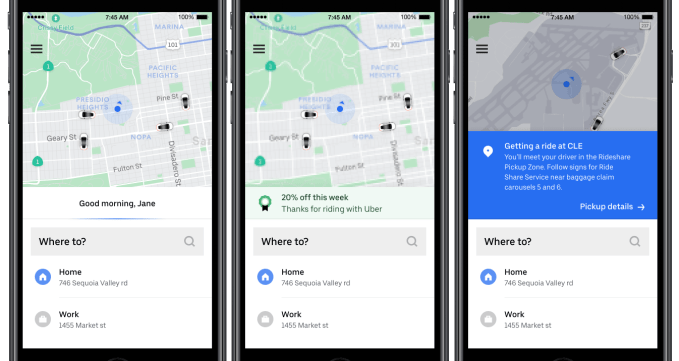
A new communication box is coming to the center of Uber’s homescreen
Uber’s data shows users are rapidly embracing the multi-modal future. A study found the introduction of JUMP bikes to one city led to a 15 percent increase in total Uber + JUMP trips, even though Uber use dropped 10 to 15 percent.
Even if Uber sometimes cannibalizes itself by recommending cheaper options, it’s a smart long-term strategy. Janakiram laughs that “If we wanted to optimize for revenue, we wouldn’t have shown UberX, Pool and Express Pool first for every user for the last few years.” The lifetime value of ridesharing users is so high that it’s worth losing a couple of bucks here or there to keep users from straying to multi-modal competitors like Lyft. Retention will be a key metric under scrutiny as it eyes a 2019 IPO at a potential $120 billion valuation.
“The big picture is that we want your phone to replace your personal car,” Janakiram concludes. “If we want to be a true transportation platform, we need to be everywhere our riders need to be, as well. The right ride for the right context, and what’s the right ride for you.”
[Disclosure: Uber’s Janakiram and I briefly lived in the same three-bedroom apartment five years ago, though I’d already agreed to write about the redesign when I found out he was involved.]
Powered by WPeMatico
Spotify has given its app a big makeover, with a focus on making the experience better for its paying subscribers. The company has simplified the app’s navigation by reducing the numbers of buttons and has revamped its Search page, which now incorporates elements previously found in “Browse,” like favorite genres or music to match a mood. And it’s given its Radio service a redesign as well, with the addition of new and easy-to-use Artist Radio Playlists.
The most immediately noticeable change is the app’s navigation.
Spotify has always felt a bit cluttered, with its five navigation buttons – Home, Browse, Search, Radio and My Library. The new app has chopped this down to just three buttons – Home, Search, and My Library.
Recommendations will appear on the Home page, following the update, while discovery is powered by Search.
The Search page lets you seek out artists, albums and podcasts by typing in queries, as before. But the page is also now personalized, showing your own “Top Genres” beneath the search bar – like R&B, Rock, Hip-Hop, Kids & Family – or whatever else you listen to. This is helpful because users’ tastes can change over time, or they may share their individual Spotify account with others (instead of opting for a Family plan), which can garble their recommendations.
The “Browse” section has moved to this Search page in the redesign, and points to things like top charts, Spotify’s programmed playlists, your own personalized playlists, plus music by mood, genre, activity and more.
The Radio section got an overhaul, too.
With the update, you can search for a favorite artist or song, then immediately start listing to one of the brand-new Artist Radio playlists. These are personalized, endless streams based on your own tastes – and they’re updated regularly to stay fresh, Spotify notes.
This latter feature appears to address a recent challenge from Pandora, which tapped into its Music Genome to create dozens of personalized playlists for its users. Spotify, effectively, is turning its radio stations into personalized playlists now, too. Instead of asking users to thumbs up/down its selections, it will just create stations it knows you’ll like, based on the data it already has. These radio playlists also work offline, the company says.
The updated app for Premium users follows a redesign of the app for its free customers, announced back in April. That redesign made it easier for free users to access over a dozen playlists with songs on demand, which also included the option to skip tracks. It also reduced the number of tabs in the bottom navigation.
This week, the company also rolled out a new Android Wear application. Plus, the third-party manufacturer Mighty launched a new version of its Spotify player, which is basically an iPod Shuffle-like device that works with Spotify instead of Apple Music or iTunes.
The changes to the Spotify app comes at a time when the company is losing ground in North America to Apple. Pandora was just snatched up by Sirius XM for $3.5 billion, which could make for increased competition in the U.S., as well.
Spotify’s Premium Subscribers grew to 83 million in Q2 2018, and it has 180 million monthly actives, including free customers, which still puts it ahead of the competition, in terms of user base size.
Spotify says the redesign for Spotify Premium is rolling out to all Premium subscribers on iOS and Android globally starting today.
Powered by WPeMatico
HTML5 almost ruined Facebook when baking in the mobile web standard to speed up development slowed down the performance of the social network’s main iOS and Android apps. For a brief moment in 2011, Facebook even tried to build an HTML5 gaming platform codenamed Sparta to escape the taxes of Apple and Google’s mobile operating systems. But at the time, HTML5 wasn’t powerful enough for great gaming. Facebook eventually ditched HTML5, rebuilt the apps natively, and Facebook became one of the most powerful players in mobile.
Now Facebook is giving HTML5 another shot as a way to expand its Instant Games like Pac-Man and Words With Friends to the developing world through Facebook Lite, and to interest communities via Facebook Groups. With improvements to smartphone processing power and the underlying mobile browser app technology, HTML5 can now support snappy, graphically-complex games like Everwing seen below.
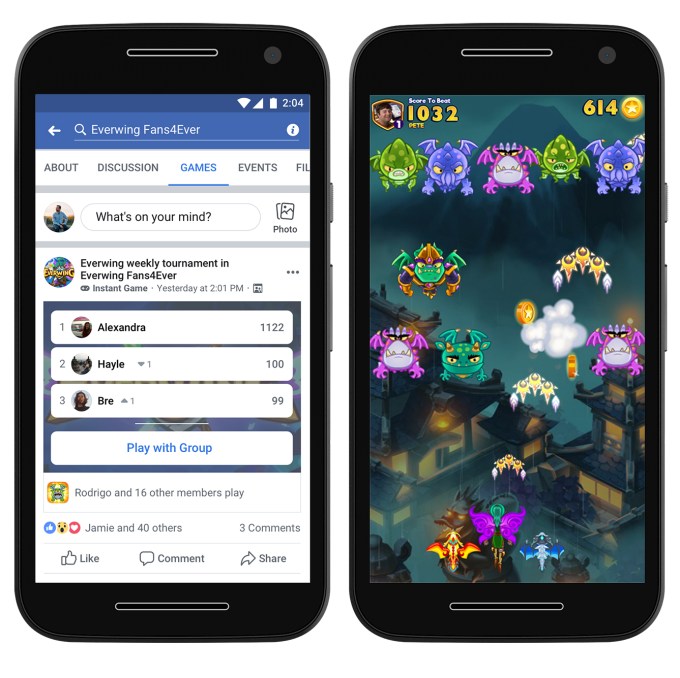
Instead of having to download separate apps for each game from the Apple App Store or Google Play, Instant Games launch in a mobile browser. That keeps Facebook Lite’s file size small to the benefit of international users with slow connections or limited data plans. And it lets Instant Games integrate directly into Groups so you can challenge not only friends but like-minded members to compete for high scores.
90 million people each month actively participate in 270,000 Facebook Groups about gaming, and now they’ll see Instant Games in the Groups navigation bar next to the About and Discussion tabs. Facebook is also considering making games an opt-in feature for non-gaming Groups. In Facebook Lite, Instant Games will appear in the More sidebar so they’re not too interruptive.
The expansion demonstrates how serious Facebook is about becoming a gaming company again. Back in its desktop days, the games platform dominated by developers like Zynga racked up tons of usage, virality, and in-game payments revenue for Facebook. That revenue declined for years after mobile usage began to dominate in 2014, but recently stabilized at around $190 million per quarter. Apparently someone is still playing FarmVille.
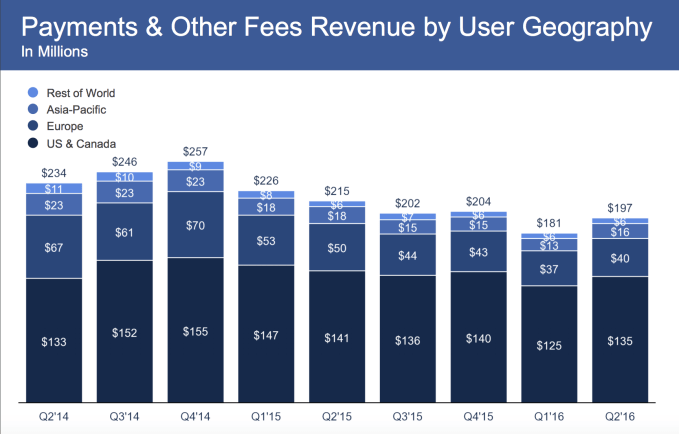
Facebook launched Instant Games in late-2016 to give people something to do while they’re waiting from friends to reply to their messages. Around the same time, Facebook launched Gameroom — a Steam-like desktop software hub for mid-core gamers, though there’s been less news on that product since. Instant Games rolled out worldwide in mid-2017, and opened to all developers in March of this year. It’s since been expanding monetization options for developers to make building Instant Games a sustainable business. That includes making Instant Games compatible with Facebook’s playable ads that let developers lure in users from the News Feed.
Facebook won’t actually be earning money from in-app purchases on Instant Games on iOS where it doesn’t allow IAP due to Apple’s policies, or on Android since it began forgoing its cut last month. It does take 30 percent on desktop though. But the bigger monetization play is in ads where Facebook is a juggernaut.
With Instant Games on Messenger, Facebook’s desktop site and main mobile app via bookmarks, its new Fb.gg standalone gaming community app, and now Facebook Lite and Groups, the company is prioritizing the space again. That seems wise as gaming becomes more mainstream thanks to players livestreaming their commentary and phenomena like Fortnite. And with Facebook’s expansion into hardware with the Portal smart screen and a forthcoming TV set-top box, it will have more places than ever for people to play or watch others duke it out.
Powered by WPeMatico